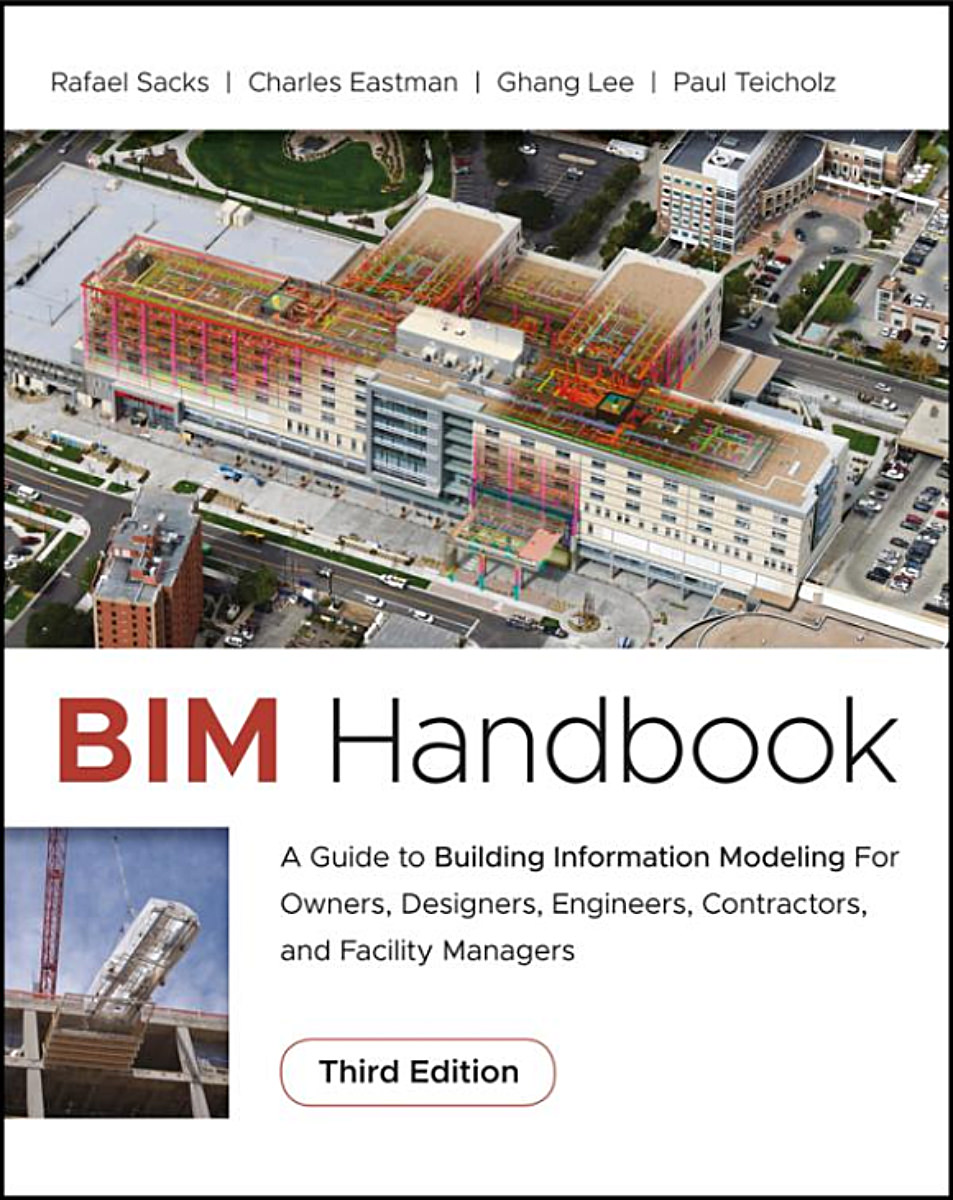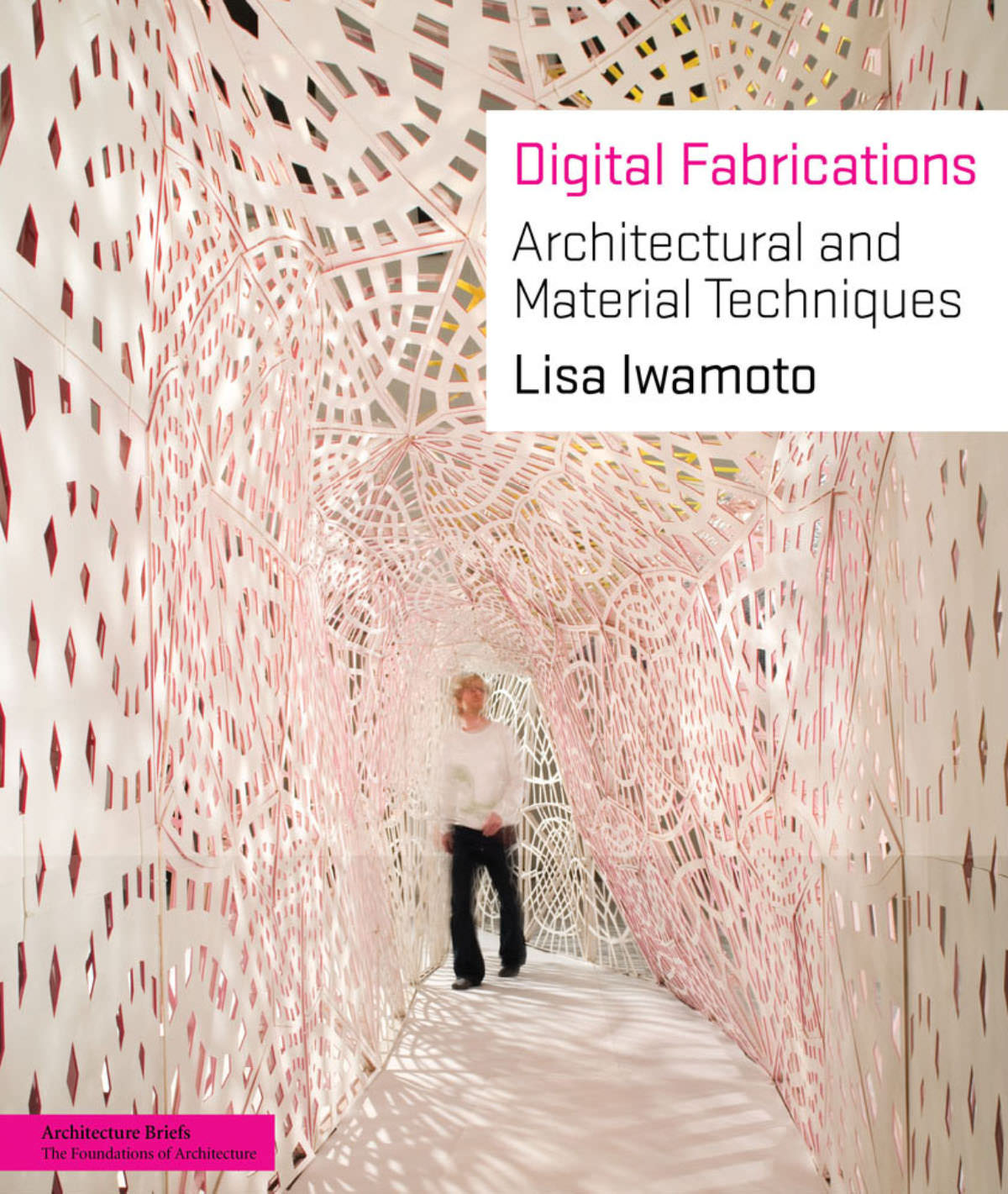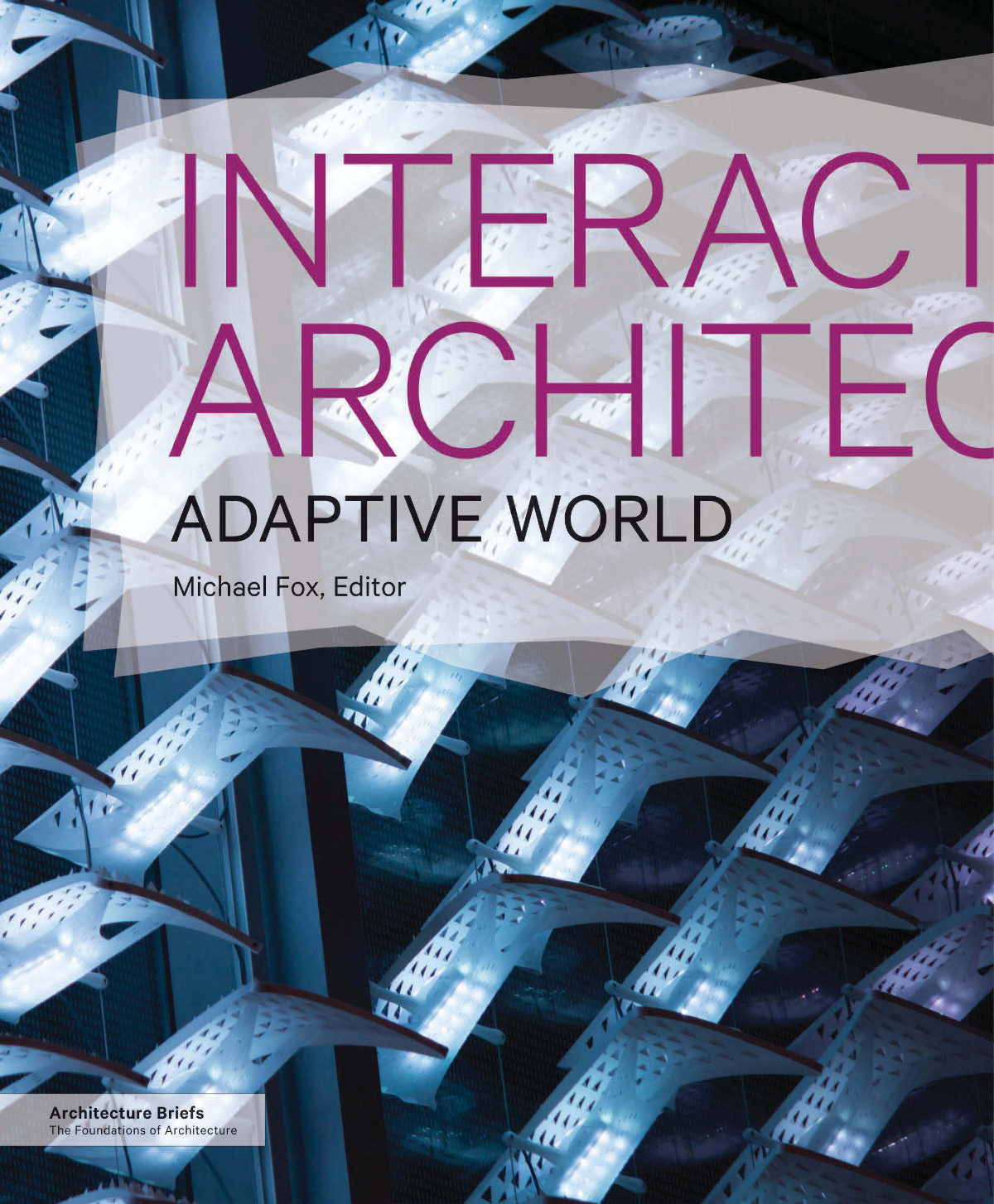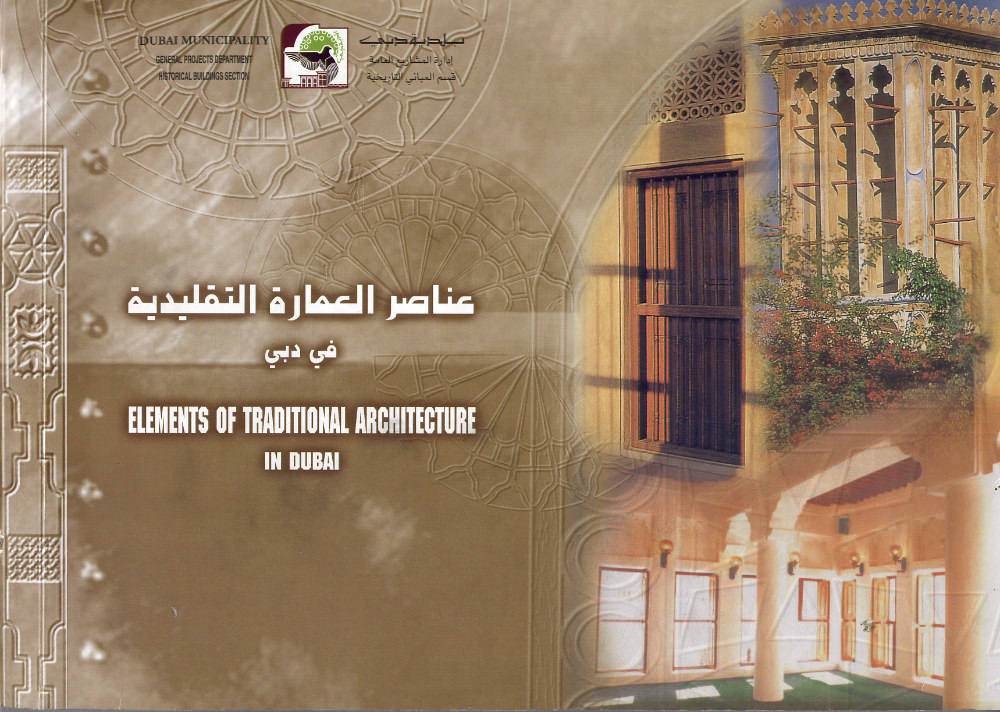Building Information Modeling (BIM) offers a novel approach to design, construction, and facility management in which a digital representation of the building product and process is used to facilitate the exchange and interoperability of information in digital format. BIM is beginning to change the way buildings look, the way they function, and the ways in which they are designed and built.
BIM Handbook: A Guide to Building Information Modeling for Owners, Designers, Engineers, Contractors, and Facility Managers 3rd Edition
12,00 $
BIM Handbook: A Guide to Building Information Modeling for Owners, Designers, Engineers, Contractors, and Facility Managers 3rd Edition
English | ISBN: 1119287537 | 2018 | 688 pages | PDF | 25 MB
Discover BIM: A better way to build better buildings
Building Information Modeling (BIM) offers a novel approach to design, construction, and facility management in which a digital representation of the building product and process is used to facilitate the exchange and interoperability of information in digital format. BIM is beginning to change the way buildings look, the way they function, and the ways in which they are designed and built.
The BIM Handbook, Third Edition provides an in-depth understanding of BIM technologies, the business and organizational issues associated with its implementation, and the profound advantages that effective use of BIM can provide to all members of a project team. Updates to this edition include:
- Information on the ways in which professionals should use BIM to gain maximum value
- New topics such as collaborative working, national and major construction clients, BIM standards and guides
- A discussion on how various professional roles have expanded through the widespread use and the new avenues of BIM practices and services
- A wealth of new case studies that clearly illustrate exactly how BIM is applied in a wide variety of conditions
Painting a colorful and thorough picture of the state of the art in building information modeling, the BIM Handbook, Third Edition guides readers to successful implementations, helping them to avoid needless frustration and costs and take full advantage of this paradigm-shifting approach to construct better buildings that consume fewer materials and require less time, labor, and capital resources.
TABLE OF CONTENTS
| Foreword to the Third Edition xvii |
| Preface xxi |
| CHAPTER 1 Introduction 1 |
| 1.0 Executive Summary 1 |
| 1.1 Introduction 2 |
| 1.2 The Current AEC Business Model 2 |
| 1.2.1 Design-Bid-Build 4 |
| 1.2.2 Design-Build 6 |
| 1.2.3 Construction Management at Risk 7 |
| 1.2.4 Integrated Project Delivery 7 |
| 1.2.5 What Kind of Building Procurement Is |
| Best When BIM Is Used? 9 |
| 1.3 Documented Inefficiencies of Traditional |
| Approaches 9 |
| 1.3.1 CIFE Study of Construction Industry |
| Labor Productivity 10 |
| 1.3.2 NIST Study of Cost of Construction |
| Industry Inefficiency 12 |
| 1.4 BIM: New Tools and New Processes 13 |
| 1.4.1 BIM Platforms and Tools 13 |
| 1.4.2 BIM Processes 14 |
| 1.4.3 Definition of Parametric Objects 17 |
| 1.4.4 Support for Project Team Collaboration 17 |
| 1.5 BIM as a Lifecycle Platform 18 |
| 1.6 What Is Not a BIM Platform? 19 |
| 1.7 What Are the Benefits of BIM? What Problems |
| Does It Address? 20 |
| 1.7.1 Preconstruction Benefits to Owner 21 |
| 1.7.2 Benefits for Design 21 |
| 1.7.3 Construction and Fabrication Benefits 23 |
| 1.7.4 Post Construction Benefits 25 |
| 1.8 BIM and Lean Construction 25 |
| 1.9 What Challenges Can be Expected? 28 |
| 1.9.1 Challenges with Collaboration and |
| Teaming 28 |
| 1.9.2 Legal Changes to Documentation |
| Ownership and Production 29 |
| 1.9.3 Changes in Practice and Use of |
| Information 29 |
| 1.9.4 Implementation Issues 29 |
| 1.10 Future of Designing and Building With BIM 30 |
| 1.11 Case Studies 30 |
| Chapter 1 Discussion Questions 31 |
| CHAPTER 2 Core Technologies and Software 32 |
| 2.0 Executive Summary 32 |
| 2.1 The Evolution to Object-Based Parametric |
| Modeling 33 |
| 2.1.1 Early 3D Modeling 34 |
| 2.1.2 Degrees of Parametric Modeling 44 |
| 2.1.3 Predefined versus User-Defined |
| Parametric Objects and Libraries 45 |
| 2.2 Beyond Parametric Shapes 48 |
| 2.2.1 Property and Attribute Handling 48 |
| 2.2.2 Drawing Generation 50 |
| 2.2.3 Scalability 52 |
| 2.2.4 Object Management and Links 53 |
| 2.2.5 Some Commonly Asked Questions 55 |
| 2.3 BIM Environments, Platforms, and Tools 57 |
| 2.3.1 Considerations for BIM Design |
| Applications 60 |
| 2.3.2 Considerations for a BIM Environment 62 |
| 2.4 BIM Model Quality and Model Checking 62 |
| 2.5 BIM Platforms 64 |
| 2.5.1 Allplan 65 |
| 2.5.2 ArchiCAD 66 |
| 2.5.3 Bentley Systems 68 |
| 2.5.4 DESTINI Profiler 69 |
| 2.5.5 Digital Project 70 |
| 2.5.6 Revit 72 |
| 2.5.7 Tekla Structures 73 |
| 2.5.8 Vectorworks 74 |
| 2.5.9 AutoCAD-Based Applications 75 |
| 2.6 Design Review Applications 76 |
| 2.6.1 Model Viewers 77 |
| 2.6.2 Model Integration Tools 79 |
| 2.6.3 Model Checkers 80 |
| 2.7 Conclusion 82 |
| Chapter 2 Discussion Questions 83 |
| CHAPTER 3 Collaboration and Interoperability 85 |
| 3.0 Executive Summary 85 |
| 3.1 Introduction 86 |
| 3.2 Different Kinds of Data Exchange Methods 88 |
| 3.3 Background of Product Data Models 95 |
| 3.3.1 Modeling Languages 95 |
| 3.3.2 ISO-STEP in Building Construction 96 |
| 3.3.3 buildingSMART and IFC 100 |
| 3.3.4 What Is the IFC? 100 |
| 3.3.5 IDM and MVD 105 |
| 3.4 Other Efforts Supporting Standardization 107 |
| 3.4.1 buildingSMART Data Dictionary 107 |
| 3.4.2 OmniClass 107 |
| 3.4.3 COBie 108 |
| 3.4.4 XML-Based Schemas 110 |
| 3.5 The Evolution from File-Based Exchange to BIM |
| Servers 112 |
| 3.5.1 Project Transactions and |
| Synchronization 113 |
| 3.5.2 Functionality of BIM Servers 118 |
| 3.5.3 BIM Server Review 121 |
| 3.6 Interfacing Technologies 124 |
| 3.6.1 Semi-Automated Approaches 125 |
| 3.6.2 Semantic Approaches 126 |
| Chapter 3 Discussion Questions 128 |
| CHAPTER 4 BIM for Owners and Facility Managers 130 |
| 4.0 Executive Summary 130 |
| 4.1 Introduction: Why Owners Should Care About |
| BIM 131 |
| 4.2 Owner’s Role in a BIM Project 133 |
| 4.2.1 Design Assessment 133 |
| 4.2.2 Complexity of Building Infrastructure |
| and Building Environment 139 |
| 4.2.3 Sustainability 140 |
| 4.2.4 Public Construction Agencies: BIM |
| Adoption Guidelines 140 |
| 4.3 Cost and Time Management 142 |
| 4.3.1 Cost Management 142 |
| 4.3.2 Time to Market: Schedule |
| Management 144 |
| 4.3.3 Facility and Information Asset |
| Management 148 |
| 4.3.4 BIM Tool Guide for Owners 149 |
| 4.3.5 BIM Cost Estimating Tools 150 |
| 4.3.6 Facility and Asset Management Tools 150 |
| 4.3.7 Operation Simulation Tools 154 |
| 4.4 An Owner and Facility Manager’s Building |
| Model 154 |
| 4.4.1 Information Content of BIM-FM Model 154 |
| 4.4.2 Alternative Approaches to Creating a |
| BIM-FM Model 155 |
| 4.4.3 Classification of Model Data and |
| Standards 157 |
| 4.5 Leading the BIM Implementation on a Project 160 |
| 4.5.1 Develop Guidelines for Use of BIM on |
| Projects 162 |
| 4.5.2 Build Internal Leadership and |
| Knowledge 164 |
| 4.5.3 Service Provider Selection 165 |
| 4.5.4 Provide for Use of a “Big Room” for |
| Design and Construction 167 |
| 4.6 Barriers to Implementing BIM: Risks and |
| Common Myths 167 |
| 4.7 Issues for Owners to Consider when Adopting |
| BIM 171 |
| Chapter 4 Discussion Questions 173 |
| CHAPTER 5 BIM for Architects and Engineers 175 |
| 5.0 Executive Summary 175 |
| 5.1 Introduction 177 |
| 5.2 Scope of Design Services 179 |
| 5.2.1 Collaborative Forms of Project Delivery 180 |
| 5.2.2 The Concept of Information |
| Development 182 |
| 5.2.3 Civil and Infrastructure Design 184 |
| 5.3 BIM Use in Design Processes 186 |
| 5.3.1 Concept Design 187 |
| 5.3.2 Prefabrication 197 |
| 5.3.3 Analysis, Simulation, and |
| Optimization 197 |
| 5.3.4 Construction-Level Building Models 204 |
| 5.3.5 Design-Construction Integration 211 |
| 5.3.6 Design Review 212 |
| 5.4 Building Object Models and Libraries 215 |
| 5.4.1 Embedding Expertise into Building |
| Components 216 |
| 5.4.2 Object Libraries 217 |
| 5.4.3 BOM Portals 220 |
| 5.4.4 Desktop/LAN Libraries 221 |
| 5.5 Considerations in Adoption for Design Practice 223 |
| 5.5.1 Justification and Platform Selection 223 |
| 5.5.2 Phased Utilization 225 |
| Chapter 5 Discussion Questions 226 |
| CHAPTER 6 BIM for Contractors 228 |
| 6.0 Executive Summary 228 |
| 6.1 Introduction 230 |
| 6.2 Types of Construction Firms 231 |
| 6.3 Information Contractors Want from BIM 232 |
| 6.4 BIM-Enabled Process Change 234 |
| 6.4.1 Leaner Construction 234 |
| 6.4.2 Less Paper in Construction 236 |
| 6.4.3 Increased Distribution of Work 237 |
| 6.5 Developing a Construction Building Information |
| Model 237 |
| 6.5.1 Production Detailing 239 |
| 6.5.2 Big Room Co-location On-site 240 |
| 6.6 Using a Contractor Building Information Model 241 |
| 6.7 3D: Visualization and Coordination 243 |
| 6.8 4D: Construction Analysis and Planning 245 |
| 6.8.1 4D Models to Support Construction |
| Planning 246 |
| 6.8.2 Benefits of 4D Models 249 |
| 6.8.3 BIM Tools with 4D Capability 250 |
| 6.8.4 BIM-Supported Planning and |
| Scheduling Issues and Guidelines 254 |
| 6.9 5D: Quantity Takeoff and Cost Estimating 255 |
| 6.9.1 Extracting Quantities from BIM Models |
| for Estimating 257 |
| 6.9.2 Guidelines and BIM Implementation |
| Issues to Support Quantity Takeoff and |
| Estimating 258 |
| 6.10 Production Planning and Control 260 |
| 6.11 Off-site Fabrication and Modular Construction 261 |
| 6.12 BIM in the Field 263 |
| 6.12.1 Delivering Design Information to the |
| Field 263 |
| 6.12.2 Coordinating Production 267 |
| 6.12.3 Surveying Site Conditions 268 |
| 6.13 Cost and Schedule Control and Other |
| Management Functions 270 |
| 6.14 Commissioning and Turnover 272 |
| Chapter 6 Discussion Questions 273 |
| CHAPTER 7 BIM for Subcontractors and Fabricators 275 |
| 7.0 Executive Summary 275 |
| 7.1 Introduction 276 |
| 7.2 Types of Subcontractors and Fabricators 278 |
| 7.2.1 Subcontractor Trades 279 |
| 7.2.2 Made-to-Stock and Made-to-Order |
| Component Suppliers 280 |
| 7.2.3 Engineered-to-Order Component |
| Fabricators 281 |
| 7.2.4 Design Service Providers and |
| Specialist Coordinators 282 |
| 7.2.5 Full-Service Design-Build Prefabricated |
| and Modular Construction 283 |
| 7.3 The Benefits of a BIM Process for Subcontractor |
| Fabricators 283 |
| 7.3.1 Marketing and Tendering 285 |
| 7.3.2 Reduced Production Cycle Times 286 |
| 7.3.3 Reduced Design Coordination Errors 287 |
| 7.3.4 Lower Engineering and Detailing Costs 291 |
| 7.3.5 Increased Use of Automated |
| Manufacturing Technologies 292 |
| 7.3.6 Increased Preassembly, Prefabrication, |
| and Modular Construction 293 |
| 7.3.7 Quality Control, Supply Chain |
| Management, and Lifecycle |
| Maintenance 296 |
| 7.4 Generic BIM System Requirements for |
| Fabricators 298 |
| 7.4.1 Parametric and Customizable Parts |
| and Relationships 298 |
| 7.4.2 Reporting Components for Fabrication 302 |
| 7.4.3 Interface to Management Information |
| Systems 303 |
| 7.4.4 Interoperability 303 |
| 7.4.5 Information Visualization 304 |
| 7.4.6 Automation of Fabrication Tasks 304 |
| 7.5 Specific BIM Requirements for Fabrication 305 |
| 7.5.1 Traditional ETO Component |
| Fabricators 306 |
| 7.5.2 Modular Construction 314 |
| 7.5.3 3D Printing and Robotic Construction 315 |
| 7.6 Adopting BIM in a Fabrication Operation 317 |
| 7.6.1 Setting Appropriate Goals 317 |
| 7.6.2 Adoption Activities 318 |
| 7.6.3 Planning the Pace of Change 320 |
| 7.6.4 Human Resource Considerations 321 |
| Chapter 7 Discussion Questions 322 |
| CHAPTER 8 Facilitators of BIM Adoption and Implementation 323 |
| 8.0 Executive Summary 323 |
| 8.1 Introduction 324 |
| 8.2 BIM Mandates 324 |
| 8.2.1 Significance of Government BIM |
| Mandates 325 |
| 8.2.2 The Status of Government BIM |
| Mandates around the World 325 |
| 8.2.3 Motivations 327 |
| 8.2.4 BIM Requirements 328 |
| 8.2.5 Challenges and Considerations 329 |
| 8.3 BIM Roadmaps, Maturity Models, and |
| Measures 330 |
| 8.3.1 BIM Roadmaps 330 |
| 8.3.2 BIM Maturity Models 335 |
| 8.3.3 BIM Measures 339 |
| 8.4 BIM Guides 340 |
| 8.4.1 BIM Guides by Region and |
| Organization 340 |
| 8.4.2 BIM Guides by Topic 342 |
| 8.5 BIM Education and Training 345 |
| 8.5.1 Transition of Senior Staff 346 |
| 8.5.2 BIM Roles and Responsibilities 346 |
| 8.5.3 Industry Training and Certificate |
| Programs 349 |
| 8.5.4 University Education Programs 355 |
| 8.5.5 Considerations for Training and |
| Deployment 356 |
| 8.6 Legal, Security, and Best Practice Issues 358 |
| 8.6.1 Legal and Intellectual Property Issues 358 |
| 8.6.2 Cyber Security for BIM 360 |
| 8.6.3 Best Practices and Other Social Issues 361 |
| Acknowledgments 361 |
| Chapter 8 Discussion Questions 362 |
| CHAPTER 9 The Future: Building with BIM 364 |
| 9.0 Executive Summary 364 |
| 9.1 Introduction 366 |
| 9.2 BIM Before 2000: Predicting Trends 367 |
| 9.3 Development and Impact of BIM: 2000 to |
| 2017 370 |
| 9.3.1 Impact on Owners: Better Options, |
| Better Reliability 371 |
| 9.3.2 Impact on the Design Professions 373 |
| 9.3.3 Impact on Construction Companies 373 |
| 9.3.4 Impact on Building Material and |
| Component Suppliers 374 |
| 9.3.5 Impact on Construction Education: |
| Integrated Education 374 |
| 9.3.6 Impact on Statutory Authorities: Model |
| Access and Review 375 |
| 9.3.7 Impact on Project Documentation: |
| On-Demand Drawings 375 |
| 9.3.8 Impact on BIM Tools: More Integration, |
| More Specialization, More Information 376 |
| 9.4 Current Trends 376 |
| 9.4.1 Process Trends 377 |
| 9.4.2 Technology Trends 381 |
| 9.4.3 Integrative Process and Technology |
| Trends 382 |
| 9.4.4 Trends in BIM Research 383 |
| 9.4.5 Obstacles to Change 385 |
| 9.5 Vision 2025 386 |
| 9.5.1 Thoroughly Digital Design and |
| Construction 387 |
| 9.5.2 A New Culture of Innovation in |
| Construction 388 |
| 9.5.3 Off-site Construction 389 |
| 9.5.4 Construction Regulation: Automated |
| Code-Checking 390 |
| 9.5.5 Artificial Intelligence in Construction 391 |
| 9.5.6 Globalization 393 |
| 9.5.7 Support for Sustainable Construction 393 |
| 9.6 Beyond 2025 394 |
| Acknowledgment 397 |
| Chapter 9 Discussion Questions 397 |
| CHAPTER 10 BIM Case Studies 398 |
| 10.0 Introduction 398 |
| Acknowledgments 401 |
| 10.1 National Children’s Hospital, Dublin 405 |
| 10.1.1 Introduction 405 |
| 10.1.2 Motivation for the Project 406 |
| 10.1.3 The Building 406 |
| 10.1.4 The NCH Project 407 |
| 10.1.5 The BIM Execution Plan (BEP) 408 |
| 10.1.6 Visualization, Simulation, and Design |
| Optimization 412 |
| 10.1.7 Summary of BIM Benefits 418 |
| Acknowledgments 419 |
| 10.2 Hyundai Motorstudio Goyang, South Korea 419 |
| 10.2.1 Project Overview 419 |
| 10.2.2 Complex Spatial Arrangement: |
| BIM-Based Design Coordination 422 |
| 10.2.3 Free-Form Patterned Exterior: |
| Panelization 423 |
| 10.2.4 Mega Truss Structure: Laser Scanning 426 |
| 10.2.5 Perception Gap between Participants: |
| VR and 4D Simulation 430 |
| 10.2.6 Needs for Schedule Reduction: |
| Multi-trade Prefabrication 433 |
| 10.2.7 Lessons Learned and Conclusion 436 |
| Acknowledgments 437 |
| 10.3 Fondation Louis Vuitton, Paris 437 |
| 10.3.1 Introduction 437 |
| 10.3.2 Project Design Workflow and Software |
| Technology 438 |
| 10.3.3 Design of the Structure and Sails 441 |
| 10.3.4 Model Analyses 442 |
| 10.3.5 Generative Detailing Using 3D |
| Intelligent Components 443 |
| 10.3.6 Concrete Iceberg Panelization and |
| Optimization for Fabrication 445 |
| 10.3.7 Fabrication of the Glass Sails 446 |
| 10.3.8 Integrated Use of the BIM Model 448 |
| 10.3.9 Lessons Learned 449 |
| 10.3.10 Conclusion 450 |
| Acknowledgments 451 |
| 10.4 Dongdaemun Design Plaza, Seoul, |
| South Korea 451 |
| 10.4.1 Introduction 451 |
| 10.4.2 Challenges during the Design Phase 452 |
| 10.4.3 Challenges during the Construction |
| Phase 456 |
| 10.4.4 BIM to Fabrication 460 |
| 10.4.5 Lessons Learned 464 |
| 10.4.6 Conclusion and Future Outlook 467 |
| Acknowledgments 468 |
| 10.5 Saint Joseph Hospital, Denver 468 |
| 10.5.1 Organizational Structure and the |
| Collaboration Agreement 469 |
| 10.5.2 The BIM Execution Plan 471 |
| 10.5.3 Simulations and Analyses 474 |
| 10.5.4 BIM Support for Prefabrication 474 |
| 10.5.5 Ensuring Metrics Help Inform Future |
| Efforts 477 |
| 10.5.6 Risk and Safety Benefits of BIM and |
| Prefabrication 478 |
| 10.5.7 BIM in the Field 479 |
| 10.5.8 BIM for Facility Management 479 |
| 10.5.9 Lessons Learned: Best Practices 480 |
| Acknowledgments 481 |
| Online Sources 481 |
| 10.6 Victoria Station, London Underground 482 |
| 10.6.1 History 482 |
| 10.6.2 The Project 483 |
| 10.6.3 Engineering Challenges 487 |
| 10.6.4 The Role of BIM 488 |
| 10.6.5 BIM Benefits to the Project 497 |
| 10.6.6 Postscript 498 |
| Acknowledgments 498 |
| 10.7 Nanyang Technological University Student |
| Residence Halls, Singapore 499 |
| 10.7.1 Introduction 499 |
| 10.7.2 Project Overview 499 |
| 10.7.3 Project Organization/Management 503 |
| 10.7.4 PPVC Workflow 503 |
| 10.7.5 BIM Implementation 508 |
| 10.7.6 Parametric PPVC Library 509 |
| 10.7.7 Benefits Realization 518 |
| 10.7.8 Conclusion and Lessons Learned 520 |
| Acknowledgments 522 |
| 10.8 Mapletree Business City II, Singapore 522 |
| 10.8.1 Introduction 522 |
| 10.8.2 Communication and Collaboration |
| Issues 528 |
| 10.8.3 BIM Coordination Meetings 529 |
| 10.8.4 BIM Execution Planning 532 |
| 10.8.5 Data Exchange 532 |
| 10.8.6 Productivity Gains 533 |
| 10.8.7 Innovative Uses of BIM 535 |
| 10.8.8 Simulation and Analysis 541 |
| 10.8.9 BIM in the Field 544 |
| 10.8.10 Conclusion 552 |
| Acknowledgments 554 |
| 10.9 Prince Mohammad Bin Abdulaziz International |
| Airport, Medina, UAE 554 |
| 10.9.1 Project Information 554 |
| 10.9.2 Novel/Innovative Use of BIM 555 |
| 10.9.3 Communication and Collaboration 558 |
| 10.9.4 Stakeholder Involvement 559 |
| 10.9.5 Risk 561 |
| 10.9.6 BIM in the Field 566 |
| 10.9.7 Lessons Learned: Problems, |
| Challenges, Solutions 567 |
| 10.9.8 Conclusion and Future Outlook 573 |
| Acknowledgments 574 |
| 10.10 Howard Hughes Medical Institute, Chevy |
| Chase, Maryland 574 |
| 10.10.1 Introduction 574 |
| 10.10.2 Background 575 |
| 10.10.3 The Challenges 576 |
| 10.10.4 An FM-Capable BIM 577 |
| 10.10.5 Impact Analysis Using an FM-Capable |
| BIM 580 |
| 10.10.6 Lessons Learned Thus Far 582 |
| 10.10.7 The Path Forward 583 |
| Acknowledgments 583 |
| 10.11 Stanford Neuroscience Health Center, Palo |
| Alto, California 584 |
| 10.11.1 Introduction 584 |
| 10.11.2 Project Details 586 |
| 10.11.3 The Pilot 587 |
| 10.11.4 Making the Case 588 |
| 10.11.5 The Journey 589 |
| 10.11.6 The Team 589 |
| 10.11.7 Executing the Pilot 591 |
| 10.11.8 Use Case Metrics 594 |
| 10.11.9 Results of Use Cases 600 |
| 10.11.10 Summary of Benefits 605 |
| 10.11.11 BIM Costs and Impact on Annual |
| Budget 607 |
| 10.11.12 Lessons Learned 608 |
| 10.11.13 Conclusion and Future Outlook 613 |
| Acknowledgments 613 |
| Glossary 614 |
| References 623 |
| Index 639 |





